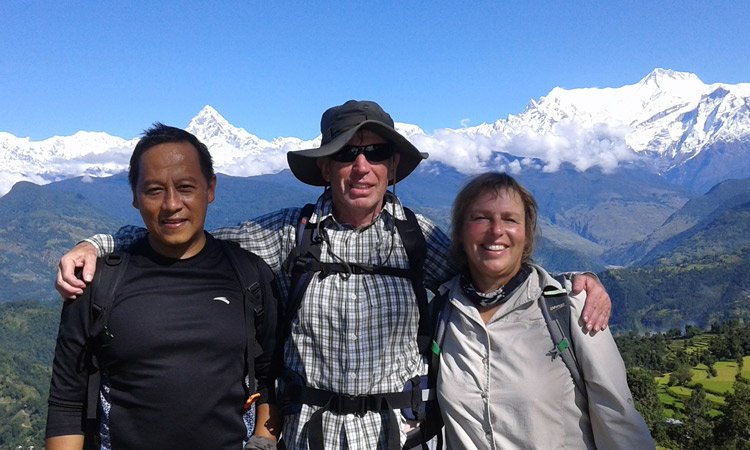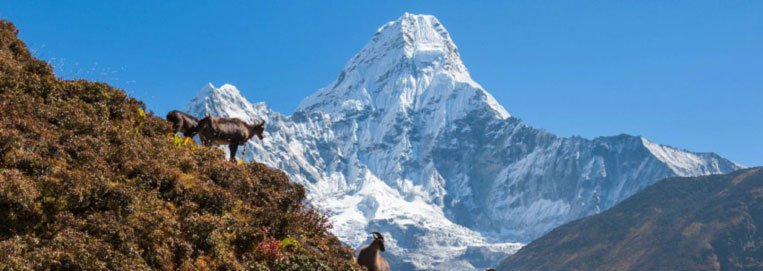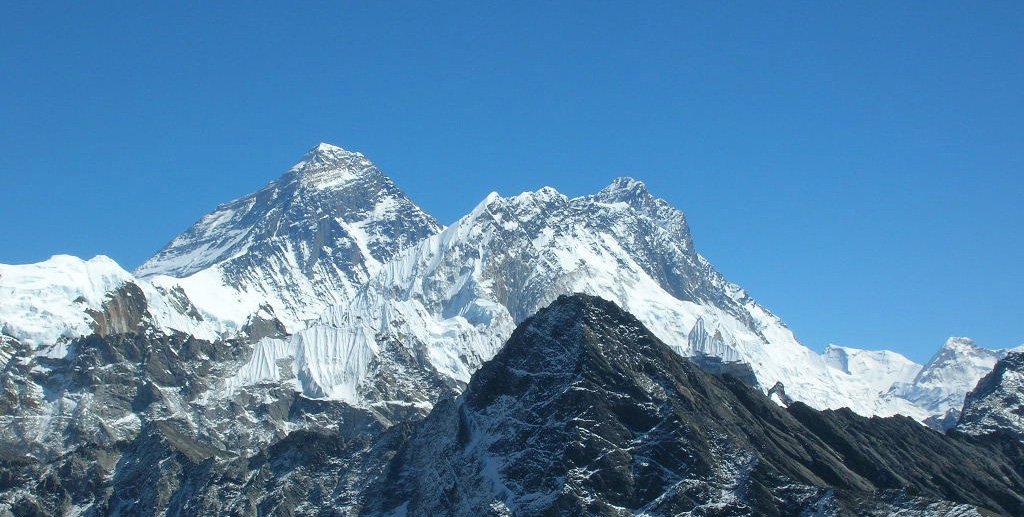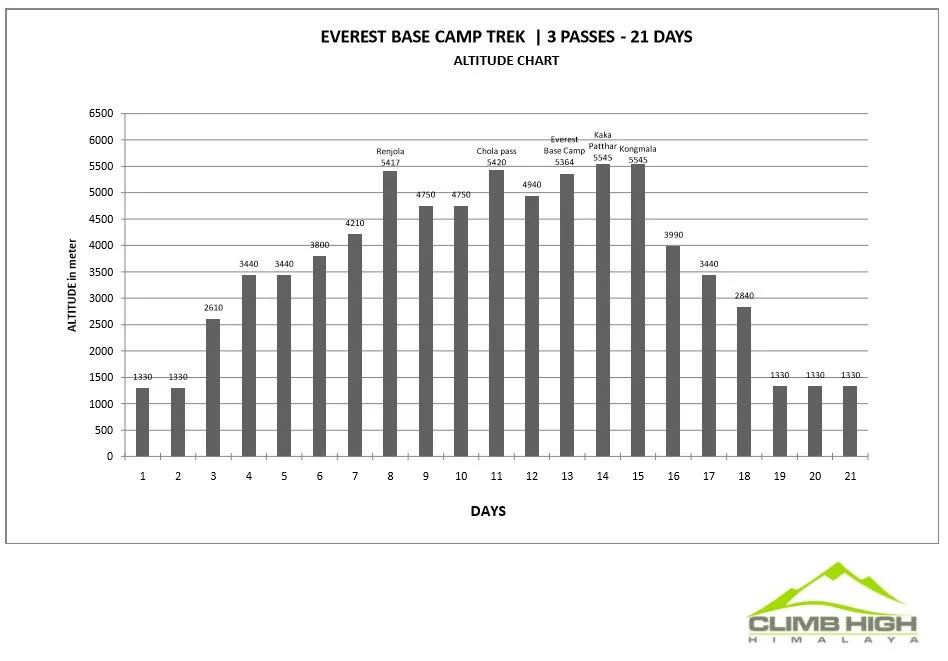
Everest Base Camp Three Passes
Everest Base Camp Trek
-
Itinerary
Our trip allows for plenty of acclimatisation time - the best way to ensure you make it to Base Camp and enjoy the experience is to follow established acclimatisation schedules and not to rush!
-
Price
This trip is US$3890 per person, based on a booking for 2 people - contact us if you have more .
-
Reservation and Enquiries
To find out more, just contact us and we’ll sort your trek out for you - organised by the locals!
Everest Base Camp Three Passes
Trip Overview
(via Renjo la / Cho la / Kongma la pass)
The world famous Everest Base Camp trek takes 21 days and reaches a maximum height of 5,545m at Kala Pattar, offering fine views of Mount Everest. The trek has a number of stunning attractions which include spectacular scenery, monasteries and the Sherpa people of the Solu Khumbu. The trek starts and finishes at Lukla where there is a small airport at 2,800m.
Our trip is a few days longer than most to allow for full acclimatisation by party members.
Introduction
This route allows you to explore the Thame valley and the Renjo la pass where the views of Everest, Pumori, Lhotse and Cho Oyu are truly amazing. You will also see fewer people on this route, and it is a far more remote trek. There are not many tea houses along this route, but those few are warm and clean.
The trek to Everest Base Camp is for good reason one of the most famous in the world, and is a ‘must-do’ trip for all outdoor enthusiasts. With awe-inspiring views of the world’s highest and most beautiful mountains, our treks are carefully organised to ensure you have plenty of time to acclimatise comfortably, making sure you can enjoy the trekking experience to the full.
The first day we have a briefing and sightseeing day in Kathmandu, where we can make sure that your kit is what you need and help you to get anything in the shops of bustling Thamel where our office is based. Then we’ll fly to the world famous mountain airstrip at Lukla and begin the trek up the Khumbu Valley. We pass through many Sherpa villages, including the famous Sherpa ‘capital’, Namche Bazaar, as well as visiting the monastery at Thyangboche (or Tengboche).
The trekking is on good trails, with some moraine stretches nearer to our destination but nowhere is this climbing or even scrambling – there are good paths all of the way. You can expect to trek for 4 to 6 hours each day, with some days spent resting and acclimatising to ensure that we are all fit and healthy at altitude. This makes the trek suitable for any averagely fit walker. On the route accommodation is in Nepal’s famous tea houses – the accommodation is basic but comfortable and the friendly, hospitable Nepali people make your stay a memorable one.
Itinerary
Day 01 : Arrival in Kathmandu
Day 02 : Rest day / Sightseeing in Kathmandu (Boudha, Pashupatinath and Swambunath)
Day 03 : Fly to Lukla and trek to Phakding
This is an hour flight from Kathmandu to Lukla Airport 2,840m. The trail from Lukla, leads north from the airstrip and drops steeply for a bit, then descends gently to Phakding 2,610m, your first overnight stop. This is a two hour trek.
Day 04 : Phakding to Namche 3,440m
From Phakding the trail continues north up the Dudh Kosi Valley. (Kosi means river in Nepali and it comes down from the Everest glacier). All along this part of the trail, there is a magnificent forest of magnolia, rhododendron and giant firs. On the cliffs above the river it is possible to see musk deer and Himalayan tahr. At Monjo the trek enters the Sagarmatha National Park. The trail follows the river and crosses Dudh Kosi and makes a steep climb to Namche 3,440m. Namche is a very colourful Sherpa village where you will see vendors selling antiques and each Saturday there is an important weekly haat or market.
Day 05 : Namche acclimatization
We stay one more extra day at Namche for acclimatisation. This will allow our bodies to become acclimatised to the altitude of 3,450m (11,300ft). We’ll see local sights and visit the village of Khumjung where there is a school built by Sir Edmund Hillary and the Himalayan Trust. The views of Ama Dablam, Thamserku and Taweche are really breathtaking. Khumjung’s elevation is 3,790m.
Day 06 : Namche - Thame 3,800m
This day is meant for acclimatisation and hence we do not embark on any serious trekking. Instead we go to a slightly lower altitude of Thame, the birthplace of Tenzing Norgay, the first man on Everest. We conduct some sightseeing of the monastery there and generally rest.
Day 07 : Thame - Lumde 4,210m
We leave after a leisurely breakfast and trek to Lumde 4,210m. It is possible to hike up the hill to visit a small settlement where yaks are grazed during the summer season. Superb views of the mountains around Langmoche.
Day 08 : Lumde – Renjo la pass 5,417m - Gokyo
An early start for the ascent to the Renjo la pass we start off on a path through the alpine meadows that eventually leads us to the highest alpine lake in the area at 5,000m. From here we enter a boulder field and moraines. We climb up through this before traversing under a large rock buttress The trail ascends steeply to the pass 5,417m where we have one of the best views in the world – Everest, Lhotse, Makalu, Chamlang, Baruntse, Cholatse, Pumori and Taweche to name but a few. A steep descent takes us down through a moraine field and finally towards the third lake at Gokyo after 5-7 hours and descend to Gokyo.
Day 09 : Gokyo
The views in the Gokyo region are tremendous. For the best view, we climb Gokyo Ri 5,357m. It is a two hour climb to the top of the peak, providing a panoramic view of Cho Oyu, Gyachung kang, Everest, Lhotse, Makalu, Cholatse and Taweche.
Day 10 : Gokyo – Thangnak 4,750m
About half way between the first lake and second lake a trail leads off across the moraine to the east. This is the route to the 5,420m Cho la into the Everest region.
Day 11 : Thangnak – Cho la pass 5,420m - Dzongla 4,843m
The pass is not difficult, but it is steep and involves a glacier crossing on the eastern side. After crossing the pass, we rest at Dzongla from where you have splendid view of Lobuche East, Ama Dablam, Taweche and Cholatse.
Day 12 : Dzongla – Lobuche 4,940m
We start heading down to Tugla. From Tugla, we head up towards Lobuche. The trail climbs higher on the moraine to a row of stone monuments in memory of six Sherpas who died in an avalanche during the 1970 Japanese skiing Expedition. The trail then drops a bit and follows the western side of the valley to Lobuche, a summer village. The ascent becomes steeper and rougher as it crosses several side moraines. After rounding a bend in the trail, the conical views peak of Pumori 7,145m comes into view.
Day 13 : Lobuche – Gorakshep 5,160m & trek to Everest Base Camp 5,364m
About three hours beyond Lobuche we reach Gorak Shep 5,160m, the site of the 1953 expedition’s base camp. Contouring along the valley side, the trail leads on to the moraine of the Khumbu Glacier and becomes quite vague, weaving between mounds of rubble. After about 3 hours we will eventually reach base camp near the foot of the Khumbu Icefall. For those visiting base camp in the spring, it is a chance to meet teams making an ascent of the mountain. Base Camp is actually spread over quite a wide area and we will spend some time wandering through it and getting a sense of what it must be like to be camped here for two whole months, whilst attempting the mountain. To go any further than base camp, you will need to be a mountaineer! A fascinating day before the return trek to Gorak Shep.
Day 14 : Kalapattar – Gorakshep 5,160m – Lobuche 4,940m
On this lower slope of this Mt Pumori a ridge extending to the south terminates in a small peak. This peak, Kalapattar, is 5,545m and provides the best vantage point for viewing Mt Everest. We will climb Kalapattar in the morning and spend some time on the top. Return to Gorakshep for breakfast and trek downwards to Lobuche.
Day 15 : Lobuche – Kongma la pass 5545m – Chukung 4,730m
After breakfast at the lodge, your day starts with walking through Khumbu glacier towards the east. After crossing the glacier and river, the trail leads up to the pass which is the highest pass of this trip. After a hard climb to the top, the trail drops steep down to the Chukung valley
Day 16 : Chukung - Pangboche
Chhukung is also the starting point for the Island Peak Climbing. The Imja Khola joins the Dudh Koshi River a little above the Pangboche Village. There is a famous monastery at Pangboche believed to have been the oldest in the Khumbu region.
Day 17 : Pangboche – Namche
From Pangboche, we descend down the alpine desert and back into greenery of pine forests. The path leads to a steep uphill climb into Tengboche. We pay our visit to the famous Tengboche Monastery. We will stop here for at least an hour and will tour the monastery. The trek from Thyangboche to Phortse Tanga is all downhill. After stopping for a short tea beak, we will continue our trek to Namche and slowly climb to Sanasa for two hours and the trail from Sanasa to Namche is pretty straight and easy.
Hot shower in Namche!!Day 18 : Namche – Lukla
Day 19 : Lukla – Kathmandu. Transfer to hotel upon arrival.
Day 20 : Rest day
Day 21 : Departure



See where it all starts
Everest Base Camp is a destination for many, a starting point for the world’s highest mountain. EBC is in itself at extreme altitude and it will be a challenge you won’t forget!


